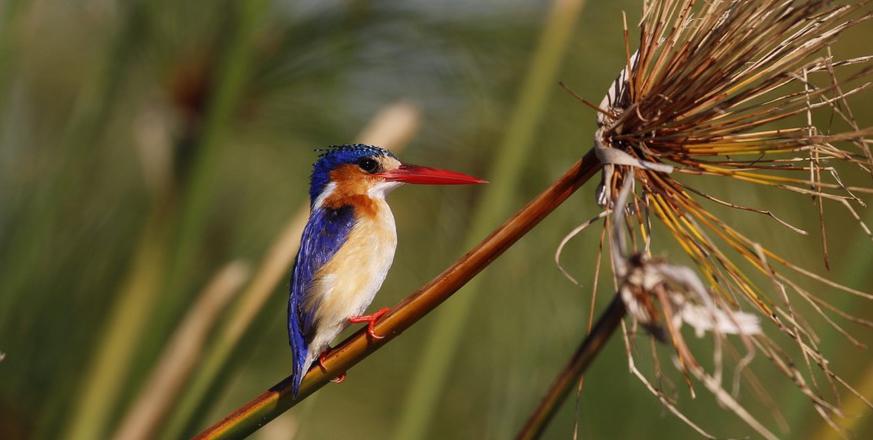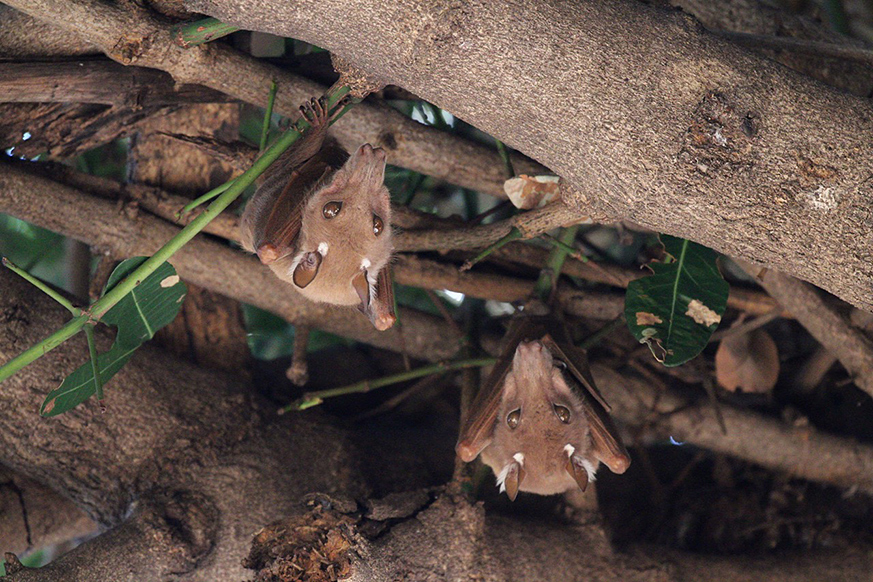Notes from the Field: Lucas Pavan - From the Third Lagoon, Okavango Delta

Our first full day in the Okavango Delta began long before the sun actually rose. We had set up our camp in the middle of a tiny island overlooking a lagoon that was rimmed on all sides by thick pockets of papyrus. A gigantic mangosteen tree, humming with bees, loomed above our tents with vine-like tendrils that hung down from the canopy. As we crawled out of our sleeping bags into the cold predawn air, Epauletted Fruit Bats greeted us with calls that sounded like insect clicks, piercing the darkness from somewhere deep within the twists of the mangosteen. While the first light of the day warmed our faces, the tufts of the papyrus smoldered like crimson candles and the dawn chorus marched forward in its predictable fashion, first the doves with their deep, chesty booms, followed by the scrub robins, sunbirds, and weavers all contributing their voices.

Epauletted Fruit Bats in the trees surrounding our camp site
After taking our time, drinking in the sights and sounds of the morning, we used the remainder of the day to explore some of the surrounding islands by foot and to appreciate the dynamic nature of the delta in a more intimate way. Just as the pure, cool water temperamentally courses through the waterways in an ever-changing pattern from year to year, islands in the Okavango float and move, symmetrically dancing with each other in a way the simultaneously opens up atria-like lagoons while constricting other lily pad-filled arteries which feed the life of the system.
I was surprised by the vibrancy and diversity of the life that resulted from this dynamic pattern, existing in tiny island pockets. Almost immediately after stepping out of the boat to start or walk we were met with our first Carmine Bee-eater, a small insect-eating birds which effortlessly cuts through the air on sharp, blade-like wings. It was easy to let myself relax on these floating fragments of woodland as I watched those birds dart above me in flashes of pink and green, but that relaxation was quickly replaced by extreme heightened awareness. Only 20 meters further into the island away from the shore we stumbled into a leopard slinking away into the grass, the white tip of its upturned tail glaringly reprimanding us as a reminder of the kinds of things that call this place home. We cautiously continued onward to some ancient palm trees on the far side of the island and watched African Palm Swifts circling above us, perhaps they were preparing to lay their eggs which they adhere to the underside of palm fronds using mud and their own saliva. As we discussed the importance of palms and palm nuts as nesting sites and as a food source for various different kinds of wildlife, a hungry herd of elephants impatiently crept up behind us, unable to wait any longer for us to finish our business. Needless to say, we took the hint and made a hasty retreat back to the boat, heading out onto the water again toward our camp.

Lucas Pavan blogging from Maun, Botswana
Skimming across our glass-like lagoon, the smell of frog and submerged vegetation misting into our noses, we spotted a rare flock of distant flamingos circling above the reeds. In my binoculars I watched their slender, graceful necks stretch far out away from their body, forming and impossibly thin line that paralleled the horizon, the rosy colors of the sunset reflected in their plumage. Again, I found myself marveling at the spectacular nature of life in the delta and the way that it is able to adapt to this continuously changing landscape, engrossed in a cycle of movement, creation, and decay that is perpetuated by its own balance. As we approached our camp, I watched the dark shapes of fruit bats flying into our mangosteen tree to roost for the night again, their high-pitched clicks welcoming us back. Ending the day exactly as we had started it, I realized I truly was in the heart of the Okavango Delta.
Lucas is a Stanford PhD student in the Dirzo Lab.
Lead photo: Malachite kingfisher on our boat trip up the Kwai River to our camping spot



